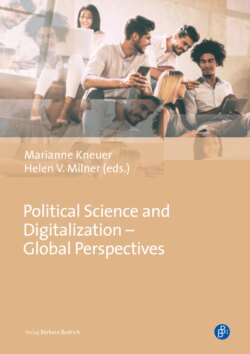Читать книгу Political Science and Digitalization - Global Perspectives - Группа авторов - Страница 15
На сайте Литреса книга снята с продажи.
3 Digital revolution, digital era and teaching/learning in political science
ОглавлениеThe digital era9 can be observed by its relationship with the social sciences in two dimensions, more specifically with political science: as a tool and as a study object. Political science has the option, first, to relate to the discipline with technologies as tools, this is, to instrumentalize these contemporary benefits in order to improve the research of traditional subjects. On the other hand, the discipline has the chance to use this framework of technologies and the information society to study its effects over politics, whether produced directly or indirectly. It is important to identify the effects of either approach. By using or studying technology in politics, one realizes that constraints in obtaining and processing data, which were traditionally more common in the natural and physical sciences, no longer exist and thus the new challenge comes in knowing how to handle this reality (Alcántara 2017).
This section focuses on technology within the curriculum and used for pedagogic purposes. The paper analyzes two aspects: first, the presence/absence of subjects that relate politics and technology, and, second, the use of digital tools in classrooms in teaching applications. For the first part, the paper analyzes the curricula of five of the seven political science programs currently in Bolivia: UMSA, UMSS, UCB, UNSLP, and UAP (Ascarrunz 2017). For the teaching methods evaluation, information from only three universities will be used: UMSA, UCB and UNSLP.10
From the five curricula obtained, three of them (all public universities) are organized by years, while the other two (from private universities) use a semester system. Whether the curricula are by year or by semester, the first courses are mainly introductory ones, such as “Introduction to Political Science” or “Introduction to International Relations”, or the basis of the study of politics, like constitutional law, economics, sociology, and history. All curricula differ from each other depending on the departmental approach, whether sociological, legalistic, or public administration oriented. From 195 courses reviewed in the five curricular designs stated, only one has direct relation with technology: “Informatics” in the seventh semester at UNSLP. Despite the fact that this course is part of the political science program, the approach is not exclusive to the discipline, since what is taught is the basics of computer management such as Microsoft Office and some SPSS, but for commercial purposes such as survey tabulations related to market studies.11 Indirectly, there are similar courses at this and other universities that can be inferred to emphasize technologies used: for example, those related to communications and political marketing [25] and/or electoral behavior12 due to recent phenomena that involve new ICTs in these processes; however, it is not possible to confirm this due lack of access to course syllabi.
On the other hand, the use of technology as a pedagogic tool, is analyzed from classes at UNSLP, UCB and UMSA. At all three universities, digital tools are limited to the use of computers, the internet, and multimedia projector. The use of these technologies depends on each subject and professor rather than on a university policy making it mandatory. In this sense, the youngest professors or the ones with studies abroad are more likely to use and exploit these tools beyond slides presentations, for example, with the connection with other professors in the world via Skype, or the use of platforms or online materials such as databases or information sites to improve and enhance interactions between professors and student. This kind of practice involves a minority of professors in most of the universities.
The problems get bigger when it comes to considering the differences between universities, which are related to both financial resources and centralization. Public universities tend to have more resources, but spending procedures are slower, while private universities do not have as many resources as public ones. Another problem is connected to the importance of political science programs for universities and students. Programs like law, social communication, or economics, among the social sciences, or architecture, business administration, or engineering are more popular among new students, both in public and private universities. This poses problems for public universities, while private universities directly decide to subsume political science under other disciplines.
Finally, the prospect does not look too different from into the near future. There are no explicit strategies by universities, university system, or governments to insert technologies into the teaching/learning processes for higher education or improving educational quality according to international standards. In this regard, if higher education in Bolivia does not embrace technologies both in its use and development, the chances of educational crisis and isolation from global scholarship increases. More specifically, political science programs, as a less popular option among students, might suffer from a higher impact on this kind of crises that could affect the whole system. Despite this negative scenario, Bolivian political science can improve its development (and its use of technologies) by modernizing, from curricula to professors, keeping closer relations with other associations, universities, and individuals.
